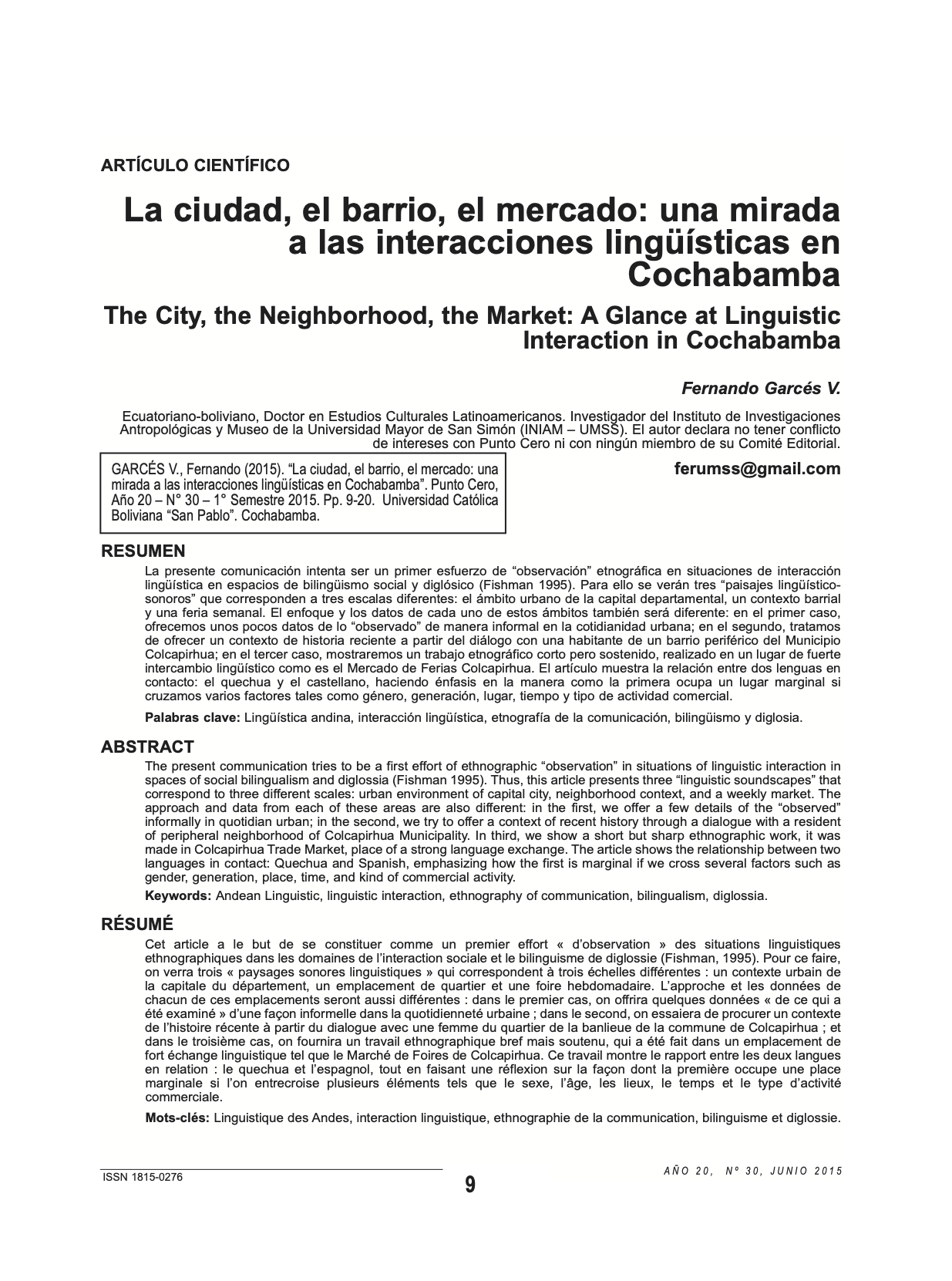The City, the Neighborhood, the Market: A Glance at Linguistic Interaction in Cochabamba
DOI:
https://doi.org/10.35319/puntocero.201530105Keywords:
Andean Linguistic, Linguistic Interaction, Ethnography of Communication, Bilingualism, DiglossiaAbstract
The present communication tries to be a first effort of ethnographic “observation” in situations of linguistic interaction in spaces of social bilingualism and diglossia (Fishman 1995). Thus, this article presents three “linguistic soundscapes” that correspond to three different scales: urban environment of capital city, neighborhood context, and a weekly market. The approach and data from each of these areas are also different: in the first, we offer a few details of the “observed” informally in quotidian urban; in the second, we try to offer a context of recent history through a dialogue with a resident of peripheral neighborhood of Colcapirhua Municipality. In third, we show a short but sharp ethnographic work, it was made in Colcapirhua Trade Market, place of a strong language exchange. The article shows the relationship between two languages in contact: Quechua and Spanish, emphasizing how the first is marginal if we cross several factors such as gender, generation, place, time, and kind of commercial activity
References
ALBÓ, Xavier (1998) Quechuas y Aymaras. La Paz. Programa Indigena, PNUD.
- (1998b). Expresión indígena, diglosia y medios de comunicación, en Sobre las huellas de la voz. Sociolingüística de la oralidad y la escritura en su relación con la educación, compilado por Luis Enrique López e Ingrid Jung. Madrid, Cochabamba, bonn: Morata, ProEIb-Andes, DSE, 126-155
BERTONIO, Ludovico (1612). Vocabvlario de la lengva aymara. Cochabamba: CErES (reimpresión facsimilar de 1984 de la edición facsimilar de 1956)
BUSTAMANTE, Martha (2003). La construcción de relaciones socioculturales en un contexto socioculturalmente heterogéneo. La Paz: Plural.
Centro Cultural JAYMA (1997). Diccionario bilingüe Quechua – Castellano, Castellano - Quechua. La Paz: Secretaría Nacional de Educación.
CERRÓN-PALoMINo, rodolfo (1987). Lingüística quechua. Cuzco: CbC.
- (2003). Castellano andino. Aspectos sociolingüísticos, pedagógicos y gramaticales. Lima: PUC-P, GTZ.
CUSIHUAMÁN, Antonio (1976). Gramática quechua Cuzco – Qollao. Lima: Ministerio de Educación, Instituto de Estudios Peruanos.
FISHMAN, Joshua (1995). Sociología del lenguaje, 4a edición. Madrid: Cátedra.
GONZALEZ HOLGUIN, Diego (1608) Vocabvlario de la lengva general de todo el Perv llamada lengua qquichua o del inca, 3a edición, 1999. Lima: Universidad Mayor de San Marcos.
GRANDA, Germán de (2001). Estudios de lingüística andina. Lima: PUC-P.
INE (Instituto Nacional de Estadística de bolivia) (2005). Atlas estadístico municipal, en http://www.ine.gob.bo/publicaciones/visorPdf.aspx?Codigo=030905&tipo=1, consulta del 19/11/12.
LARA, Jesús (1971). Diccionario Queshwa – Castellano, Castellano – Queshwa, 4a edición, 1997. Cochabamba: Los Amigos del libro.
MUYSKEN, Pieter (2000). A la mitad entre el quechua y el español: el caso de la relexificación, en Estudios de
sociolingüística, compilado por Yolanda Lastra. México: UNAM, 239-271.
OJALVO, orlando et al. (2010). “Colcapirhua, una ciudad de contraste”. Cochabamba: Axioma. Extraído de: http://arandu.serbolivianoes.org.bo/index.php?title=Colcapirhua, consulta del 23/06/12.
QUIROZ, Alfredo (2000). Gramática quechua. La Paz: Ministerio de Educación, UNICEF.
RODRIGO, Miquel (1999). La comunicación intercultural. barcelona: Anthropos
SÁNCHEZ, Walter (2010). Sin purezas y con mezclas. Las cambiantes identidades sonoras negro-africanas en bolivia, en: http://www.museo.umss.edu.bo/wp-content/uploads/2012/03/15-Sin-purezas-y-con-mezclas-Walter-Sanchez.PDF, consulta del 08/11/12).

Downloads
Published
How to Cite
Issue
Section
License
Copyright (c) 2015 Revista Punto Cero

This work is licensed under a Creative Commons Attribution-NonCommercial 4.0 International License.








